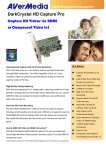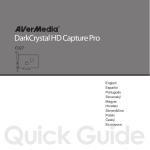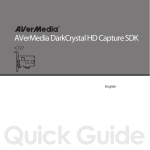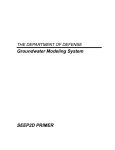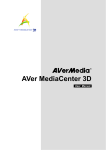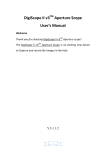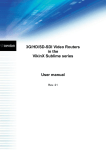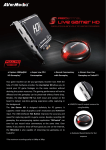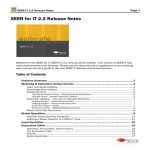Download AVer MediaCenter
Transcript
AVer MediaCenter User Manual Disclaimer All the screen shots in this documentation are only example images. The images may vary depending on the product and software version. Information presented in this documentation has been carefully checked for reliability; however, no responsibility is assumed for inaccuracies. The information contained in this documentation is subject to change without notice. Copyright ©2010 by AVerMedia Technologies, Inc. All rights reserved. No part of this document may be reproduced or transmitted in any form, or by any means without the prior written permission of AVerMedia Technologies Inc. AVerMedia Technologies Inc. reserves the right to modify its models, including their characteristics, specifications, accessories and any other information stated herein without notice. The official printout of any information shall prevail should there be any discrepancy between the information contained herein and the information contained in that printout. "AVerMedia" is a trademark (or registered trademark) of AVerMedia Technologies, Inc. Other trademarks used herein for description purpose only belong to each of their companies. International Headquarter Address No. 135, Jian-Yi Road Chung-Ho City, Taipei Hsien Taiwan Website www.avermedia.com Telephone 886-2-2226-3630 MCS-1.7.8 201006 Table of Contents Chapter 1 Introduction ......................................................................... 5 1.1 Device Introduction .........................................................................................6 1.2 System Requirements .....................................................................................7 1.3 Activating AVer MediaCenter ..........................................................................7 1.4 Overview of AVer MediaCenter........................................................................8 Aver MediaCenter Console ....................................................................................................... 8 Control Buttons On Title Bar .................................................................................................... 9 Control Buttons On Playback Window Control Panel .............................................................. 9 Navigation Tree....................................................................................................................... 10 1.5Running AVer MediaCenter for the First Time ................................................. 11 Chapter 2 Getting Started .................................................................. 13 2.1 Capture ...........................................................................................................14 Capture in Live ....................................................................................................................... 15 Operations of TimeShift .......................................................................................................... 16 Operations of Recorded Files .................................................................................................. 17 Using Schedule Recording ...................................................................................................... 18 2.2 Video ...............................................................................................................20 Playing Video Files ................................................................................................................. 20 2.3 Music ..............................................................................................................21 Adding Music to your Playlist ................................................................................................ 21 Playing Music ......................................................................................................................... 22 2.4 Images ............................................................................................................23 Viewing the Captured Images ................................................................................................. 23 Playing Slide Show ................................................................................................................. 23 Chapter 3 Advanced Operations ........................................................ 24 3.1 General Settings ............................................................................................25 Configure Recording ............................................................................................................... 25 Configure Snapshot ................................................................................................................. 26 More Options .......................................................................................................................... 27 3.2 Capture Settings ............................................................................................28 Configure SD Input Source > SD recording format ................................................................ 28 Configure SD Input Source > SD Timeshift & Color Adjustment .......................................... 29 Configure SD Input Source > SD Color Adjustment .............................................................. 29 Configure HD Input Source .................................................................................................... 30 Video Standards ...................................................................................................................... 31 Closed Caption ........................................................................................................................ 31 3.3 Video Settings ................................................................................................32 Picture-in-Picture(PIP) / Picture-by-Picture(PBP) Display .................................................... 32 3.4 Images Settings .............................................................................................33 3.5 About ..............................................................................................................34 Appendix ............................................................................................. 35 Hot Keys ................................................................................................................................. 36 Glossary .................................................................................................................................. 37 Chapter 1 Introduction Thanks for purchasing AVer Media DarkCrystal HD Capture SDK. This high quality capture card is especially designed for professional players with high standards towards image/ video quality. AVer Media DarkCrystal HD Capture SDK also comes with a powerful application AVer MediaCenter, allowing you to capture high resolution images, record HD video clips, create your own slideshows with both the captured and images of other sources, and even create your own music library for both audio and video luxury. Each function of AVer MediaCenter goes further with detailed options for a more professional taste. There is no more need to compromise yourself with all fixed default settings using a capture card. This Chapter will guide you through the essential information of AVer MediaCenter. Please read this chapter before using AVer MediaCenter. Device Introduction ........................... 6 System Requirement......................... 7 Activating AVer MediaCenter ............ 7 Overview of AVer MediaCenter ......... 8 Running AVer MediaCenter for the First Time ................................................. 11 1.1 Device Introduction What is video capture card and what can it do? Video capture cards are a class of video capture devices designed to plug directly into expansion slots in personal computers and servers. A video capture card product typically includes a driver to get the device going and a bundled software to bring out the best features of it. The bundled software usually further processes the video for specific purposes. The functions of the video capture cards vary from one another. Some are used to capture base band analog composite video, S-Video, some are equipped with tuners, RF-modulated video, some others are specialized cards that support digital video via digital video delivery standards including Serial Digital Interface (SDI) and some, with the emerging hi-tech HDMI standard becoming more popular, support both standard definition (SD) and high definition (HD) variants, and this AVer Media DarkCrystal HD Capture SDK you just purchased belongs to the last model. The functions of the supplied AVer MediaCenter for video capture cards include converting a live analog source into some type of analog or digital media, (such as a VHS tape to a DVD), archiving, video editing, scheduled recording (such as a DVR), etc. Product Name AVerMedia DarkCrystal HD Capture SDK Model No. C727 Supported Signal S-Video / Composite (RCA) / Component (YPbPr, 1080i/720p) / Sources HDMI (HDCP spupport, 1080i/720p) / Analog Audio L/R Introduction 6 1.2 System Requirements System requirements are described in details below. Before using AVer MediaCenter, please verify that your PC meets the requirements below. For SD Video Capturing: Intel Pentium 4 3.0 GHz (Hyper-Threading) AMD Athlon 64 3200+ For HD Video Real-time Capturing (MPEG-2 Format): Intel Core 2 Duo 2.4 GHz AMD Athlon 64x2 Dual Core 2.8 GHz For HD Video Real-time Capturing (H.264 Format): Intel Core i5 750 or AMD equivalent VGA card with DirectiveX9.0c or above 512 MB RAM PCI-E Slot Sound card Windows 7/ Vista/ XP (32/ 64-Bit) Standalone graphics card is recommended for HD video capturing. 2GB RAM is recommended for HD video capturing 1.3 Activating AVer MediaCenter To launch AVer MediaCenter, double-click shortcut on desktop, or go to Start -> Programs -> AVerMedia. If AVer MediaCenter is launched, double-click AVer Quick “ ” icon on the lower right of the system tray. Introduction 7 1.4 Overview of AVer MediaCenter The functions of AVer MediaCenter are categorized into five buttons on the main menu, including “Capture”, “Video”, “Music”, “Images” and “Settings”. This section briefly introduces main menu, sub menus and initial setups. For more information on advanced operations, please refer to contents from Chapter 2. AVer MediaCenter Console Description Title bar: Control over AVerMedia Console Main function menu: Capture, Video, Music, Images, Settings Playback window: Display of the selected source/ file Playback window control panel: Control over the Playback window System time display: indication of current time Introduction 8 Control Buttons On Title Bar Click To … Go back to the main menu Go back to a previous level Bring out the user’s manual Minimize AVerMedia Console to system tray Restore AVerMedia Console to previous size Exit AVerMedia Console Control Buttons On Playback Window Control Panel Click / To … Switch from real-time video to TimeShift mode. / Pause the playback temporarily. Stop playback, recording, TimeShift, etc. Play the selected file. Record the current program. Play the previous/next file on the playlist. Move backward or skip forward in intervals. Capture a single image or a sequence of images. Enable the PIP function. Switch to different aspect ratios. Mute/ Unmute the audio volume. Increase or decrease the audio Volume. Introduction 9 Navigation Tree This is an overview of the operations under each main function. For specific operation of each function, please refer to the table of contents and go to its according page. Introduction 10 1.5 Running AVer MediaCenter for the First Time When you run the AVer MediaCenter for the first time, the Setup Wizard will automatically pop up and take you through all the necessary steps for a complete setup. 1. When Setup Wizard dialog box appears, click Yes. 2. Select AVerMedia C727 HD Capture Device under Primary Device dropdown menu and click Next to continue. Introduction 11 3. Select from the dropdown menu of Country/ S-Video/ Composite Video/ HD Input according to the place you use this device, the signals provided in your region, and the signals of the equipment connected to your PC. Then click Next. 4. The wizard will guide you through to complete the setups for the available signals. Click Next to continue or click Skip to ignore the setups. 5. Click Finish to complete the initial settings or click Next to set up other devices if any. Note: To re-configure all the settings, go to “Settings” “General” “Run Wizard Again.” Introduction 12 Chapter 2 Getting Started This Chapter includes descriptions of the five main functions on AVer MediaCenter main menu. Each basic operation is followed by more detailed information on sub menu under each function. Before using the AVer MediaCenter, it is highly recommended to read through the contents of this chapter. Capture ............................................ 14 Video ................................................ 20 Music................................................ 21 Images ............................................. 23 Getting Started 13 2.1 Capture You can capture a high quality still image, a sequence of continuous images, or record a video clip when watching videos either from live or previously recorded sources or playing games in AVer MediaCenter. Basic Operations 1. Select a video source from the left menu and then the desired input signal source from the dropdown menu on the upper right. 2. Click to capture a still image or to record a clip of video during the video playback. The captured/ recorded files are saved under Recorded Files. Getting Started 14 Capture in Live Live video refers to any available current video source ready for playback. This can refer to any supported signal coming from the connected device, such as a DVD player or a video gaming device. Note : Video source setup is supposed to be completed when running AVer MediaCenter for the first time. If not, please go to Settings -> General for reconfiguration. 1. 2. 3. Select an input source from the dropdown menu on top of the main playback window. Click on the control panel to start the playback. Click to get a still image or to start recording a clip of video. Click again to stop the recording. The captured images/ video clips are saved in Recorded Files. Note 1. To find the captured/ recorded files, click Recorded File button on the left. 2. To change the storage location of the captured/ recorded files, go to Settings -> General -> Configure Storage. Getting Started 15 Operations of TimeShift The TimeShift function performs background recording of a video playback, and allows you return to any part of the recorded program. At the same time, the live program continues to be recorded and played back so you won’t miss any part of the show. You can also advance forward to skip commercials or rewind to replay scenes again. 1. Select an input source from the dropdown list on the right. When the playback starts, click TimeShift on the left menu. 2. Click on the control panel. Both the background recording time and the current-show time are shown on the upper-right of the main playback window. 3. Click to move backward in fixed intervals until reaching the part where you left off. Note The application will create a temporarily recorded file when the TimeShift function is on for an ongoing video. This file will be removed when you select . Getting Started 16 Operations of Recorded Files All the recorded files are listed with recording time and date. Reorganize the files with the menu on the left. 1. 2. 3. Go to Capture -> Recorded Files. Reorganize the recorded files by checking the options provided on the left menu. Select the desired file from the list and then click on the control panel to start playback. Getting Started 17 Using Schedule Recording The TimeShift function performs background recording of a program, and lets you return to any part of the recorded program. 1. Go to Capture -> Schedule Recording. 2. Click New Schedule to go to detail setting window. 3. Edit a name for the schedule, and select the desired option from the dropdown menu under Task and After Playback Mode. Click Save on the left menu to save your settings and bring up the next edit window. Getting Started 18 4. Select the desired signal Source under Source. 5. Check the desired recurrent frequency and enter the date of the program for the schedule. Click Save on the left menu to save your settings and bring up the next edit window. 6. Enter the airing time of the program to be recorded. 7. Select the file format for the program to be recorded. 8. Enter the duration of the program to be recorded. 9. Check Split file Size if the file size of the program to be recorded is estimated to be over the capacity of one DVD. This is useful if you want to burn the file onto DVD disks. 10. Click to change the default destination folder for recorded files. Getting Started 19 2.2 Video You can watch video files besides the recorded files in Video. Playing Video Files 1. 2. Go to “Video”. The video files recorded by AVer MediaCenter are listed on the right. Double click to start playing the selected file. Use the main playback window control panel to control the playback. 3. To find more videos, click Change Disk on the left menu, all available disks on your PC are shown in thumbnail icons on the right. 4. Click on the icon to locate where other video files are. Getting Started 20 2.3 Music You can add, delete, and reorganize your music files and create your own library for enjoyment in Music. Adding Music to your Playlist 1. Go to “Music” “Add Music” and then the desired folder of music files. 2. Select the tracks you wish to add to the playlist. 3. Select OK to go back to the previous level. 4. The selected files are added to the blanks on the right of the window. 5. Click / to reorder the playback sequence. 6. Click to remove one track or select Remove All to delete all tracks in the playlist. Getting Started 21 Playing Music To play music: 1. 2. Go to “Music”. Check Sequential to play tracks in order or Random for shuffle playback. 3. Check Loop for repeat playback. 4. 5. Click to start playing music. Click on the following buttons to control your playback. Advance the playback. Rewind the playback. Play the next track. Play the previous track Freeze the playback. End the playback Getting Started 22 2.4 Images Images allows you not only to view captured images/ pictures but create and playback a slide show. Viewing the Captured Images 1. 2. Go to “Images”. The captured images are displayed in matrix on the right of the window. 3. Click on the thumbnails to view the images in full screen. 4. Click More Pictures to locate the folder of the desired pictures and add them to the Images. Note: You can view thumbnails and enjoy live music at the same time Playing Slide Show 1. 2. Go to “Images”. Click Play Slide Show to start a slide show. 3. To stop the slide show and go back to the previous page, click on Title Bar. Getting Started 23 Chapter 3 Advanced Operations Beyond basic usage, what else you can do with AVer MediaCenter in this chapter; we take you to the next level and explain the advanced features of this application. General Settings.............................. 25 Capture Settings ............................. 28 Video Settings ................................. 32 Images Settings............................... 33 About ............................................... 34 3.1 General Settings In General Settings, you can change the destination folder for recorded files, edit recording time and file size, assign the number of image you want to capture, and reset the Windows power options, etc. Configure Recording 1. Go to “Settings” “General” “Configure Recording”. 2. Click to locate a preferable folder for recorded files as desired. 3. Click to go back to the previous level or Click Change Disk on the left menu to relocate from hard drives. 4. Click OK to confirm the selection. 5. Enter the desired length of recording time, or the recording continues until the hard drive of recording storage folder reaches its maximum capacity. 6. AVer MediaCenter allows you to divide the recorded files in segments for burning onto CD (650 MB) and DVD (4096 MB). Check Split File Size and select the appropriate video file size from the drop-down menu so that CD/ DVD burning doesn’t fail due to over-sized files. Or you can click Customize to assign the file size you want. 7. Click Save to save the settings or click Cancel to abort without saving. To change back to factory default settings, click Default. More Settings 25 Configure Snapshot 1. Go to “Settings” “General” “Configure Snapshot”. 2. Click to locate a preferable folder for captured images. 3. Enter the desired number of images to be captured, the interval between each image taken, and the format of the captured image to be saved. Advanced Operations 26 More Options 1. Go to “Settings” “General” “More Options”. 2. Select the language for the application. 3. Click Save to confirm the selection. Advanced Operations 27 3.2 Capture Settings In Capture settings, you can select SD (Standard Definition) or HD (High Definition) sources for capture/ recording results. SD input sources usually refer to signals coming from analog TV systems, VCR (Video Cassette Recorder)/ VHS or older video game stations, connected by composite RCA connectors or S-Video (Separate Video) 4-pin mini-DIN connectors. Configure SD Input Source > SD recording format 1. Go to “Settings” “Capture” “Configure SD Input Source”. 2. 3. Click Configure Recording. Select a desired file format from the dropdown menu for the recorded file. 4. Click Edit to bring out an edit page on more detailed settings of the file to be recorded. Advanced Operations 28 Configure SD Input Source > SD Timeshift & Color Adjustment 1. Go to “Settings” “Capture” “Configure SD Input Source” 2. 3. Click Configure Timeshift. Check to decide on the video quality of SD Timeshift. Configure SD Input Source > SD Color Adjustment 1. Go to “Settings” “Capture” “Configure SD Input Source” 2. Click Configure Color Adjustment. 3. Use / to adjust the values for SD color brightness, contrast, hue, saturation and sharpness. 4. Check Apply All to confirm all your settings. Advanced Operations 29 Configure HD Input Source In Capture settings, you can select SD (Standard Definition) or HD (High Definition) sources for capture/ recording results. HD signal sources usually refer to any video system of higher resolution than standard-definition (SD) video, and most commonly indicates resolutions of 1,280×720 pixels (720p) or 1,920×1,080 pixels (1080i/1080p). HD signals sources usually come from digital TV systems, set-top boxes, the optical disc delivery system such as upconvert DVD players, HD DVD players, and Blu-ray Disc players, the video tape format D-VHS or latest video game stations, connected by component connectors or HDMI cables. 1. Go to “Settings” “Capture” “Configure HD Input Source”. 2. 3. Select Configure Recording. Select the desired format for the recorded file from the dropdown menu. 4. Click Edit to bring out an Edit page. 5. Click to select an option from the dropdown menu, and use / to adjust the values for HD recording sizes, rate and audio quality. Advanced Operations 30 Video Standards In Video Standards, you can change the settings that were made when you first ran the AVerMedia Center. Click to select from the dropdown menu and then Save to confirm your changes. 1. Go to “Settings” “Capture” “Video Standards”. 2. Click to select the desired options from the dropdown menu for from Country/Region to HD Input Source. Closed Caption The "closed" in Closed Caption means that only those who choose to decode or activate this function can see the captions of the audio script on the programs, and sometimes non-audio descriptions or information of the programs are included as well. This function is initially designed for the hard of hearing, and then extended its service for people whose first language is not the spoken language, for most of the time it refers to English. 1. Go to “Settings” “Capture” “Closed Caption”. 2. Click to select the desired closed captioning channels from the dropdown menu. Advanced Operations 31 3.3 Video Settings Picture-in-Picture(PIP) / Picture-by-Picture(PBP) Display With the PIP/PBP feature, you are able to playback recorded video files, and at the same time, watch video. 1. 2. Go to “Video” “More Videos”. Select the desired file, or select to locate the desired video files. 3. When playing the video file, click on the control panel to enable the PIP (Full Screen function. 4. Click Mode) to switch between Full screen mode, PIP mode and PBP mode (as shown on the right). 5. By default, the selected recorded video is displayed on the main screen, and the live video source is on the PIP/PBP (PIP Mode) screen. 6. To switch and listen to the sound of either video, click on the arrow buttons to switch between the PIP/PBP screens. (PBP Mode) 7. In PIP mode, to change the size of the to shrink the PIP screen, click to enlarge the image or click image. 8. To exit the PIP-sizing mode, click . Advanced Operations 32 3.4 Images Settings In Images settings, you can set up the playback details for the captured images, or even add in other images of your previous collection to edit your own slide show. 1. 2. Go to “Settings” “Images”. From Play Settings dropdown menu, select Sequential to play a slide show in order or Random for shuffle playback. 3. Enter a number under Interval Time for each image to be shown. 4. Select the transition effect between image shift under Transition Effect. 5. Click to locate a preferable folder for recorded files as desired. 6. During the location of a desired folder for the recorded files, click to go back to the previous level or Click Change Disk on the left menu to relocate from hard drives. 7. Click OK to confirm the selection. 8. Check Including Sub-Folder Pictures to create a slide show with all the pictures in the current folder and its subfolder. 9. Check Hide window on slide show mode to view pictures without frames. 10. Click Save to confirm your settings or click Cancel to abort without saving. Click Default on the left menu to restore to factory default settings. More Settings 33 3.5 About AVer MediaCenter provides a convenient tool, allowing users to access to our customer after sale service via AVerMedia’s website easily. 1. 2. Go to “Settings” “About”. Connect to the Internet and then click Product Information to access the product information webpage. Or Click Technical Support to connect to our technical support webpage. 3. Please leave the information on your product model and driver version on the webpage for us to solve your problems more efficiently. More Settings 34 Appendix More tips and explanations are included in this chapter. Hot Keys ................................................ 36 Glossary ................................................ 37 Hot Keys Hot Keys Description Up/Down/Left/Right arrow Tab Space Move up, down, left or right to select the desired item. F1 F8 F9 F10 Back Ctrl + A Ctrl + Shift + A Ctrl + D Ctrl + E Ctrl + Shift + F Ctrl + I Ctrl + M Ctrl + N Ctrl + Shift + N Ctrl + O Ctrl + P Ctrl + Shift + P Ctrl + S Ctrl + Shift + S Ctrl + T Ctrl + Shift + T Alt + Home Ctrl + R Ctrl + Shift + R Alt + T Alt + B Alt + G Alt + R Alt + Y Alt + Shift + S Alt + S Alt + P Alt + M Ctrl + Shift + C Move to next item. Confirm the selected tracks or folders when under the main menu -Music. Open the user manual. Turn off / on the sound. Volume Down Volume Up Back to previous page Choose between available audio modes. Change aspect ratio Display the OSD. A shortcut to your main menu-- “Video”. Skip forward in intervals. A shortcut to your main menu-- “Images” A shortcut to your main menu-- “Music” Capture an image or a continuous sequence of images. Play next file in the playlist. View the recorded file list. Freeze the playback temporarily. Play the selected file. Stop the playback, recording, TimeShift, etc. Enable the TimeShift function. A shortcut to your main menu-- “Capture” Show Video programs in full screen. Go to the main page of AVer MediaCenter Record the current program. Play previous file in the playlist. View Teletext information. Jump to the Blue Teletext page. Jump to the Green Teletext page. Jump to the Red Teletext page. Jump to the Yellow Teletext page. Set the time to put your computer into Stand By/Hibernate mode, exit the application or turn off the computer. Turn on/off the PIP-sizing function. Turn on/off the PIP-positioning function. Activate the Picture in Picture function (PIP). Switch between available signal sources. Appendix 36 Glossary AVI A video format base on H.264 standard but has smaller video bit rate. It’s an iPod -compatible AVI is the most common video file format for format. playback on the computer. It can be saved in uncompressed form if you want high quality video, or compressed using any of the available codecs if you want to minimize the file size. Aspect Ratio MPEG-2 Videos compressed using MPEG-2 have extremely high quality pictures and full CD-quality sound. Choose MPEG-2 format for video files that are intended for DVD-ROM Aspect ratio indicates the ratio of the width of an image to its height. The two most common playback on a computer or if you want broadcast quality videos. aspect ratio of home video is 4:3 and 16:9. DVD PIP (Picture in Picture) PIP allows you to view two or more video When you choose this format, the recorded video file will be saved in MPEG-2 format that is sources at the same time wherein the small inset screens overlaid on the main screen. compliant with DVD standards. Standard DVD frame size and frame rate are 720 x 480 pixels at PBP (Picture by Picture) 29.97 fps for NTSC and 720 x 576 at 25 fps for PBP allows you to view two or more video PAL. H.264 sources side by side on a display so that all channels are visible. Videos compressed using MPEG-4 standard are Stand By two or three times more efficient than MPEG-2. Stand By is a state in which your monitor and This format can be applied to a wide variety of hard disks turn off, so that your computer uses applications or networks and systems like less power. HD-DVD, Digital TV, Broadcast and Streaming applications. Hibernate Hibernation is a state in which your computer shuts down to save power but first saves everything in memory on your hard disk. iPod Appendix 37 www.avermedia.com Appendix 38








































